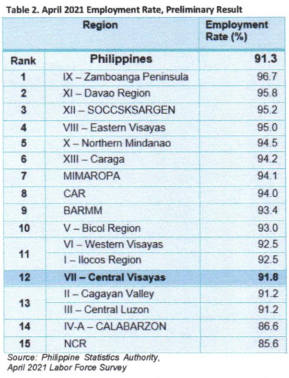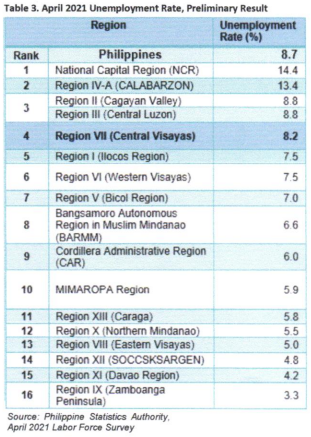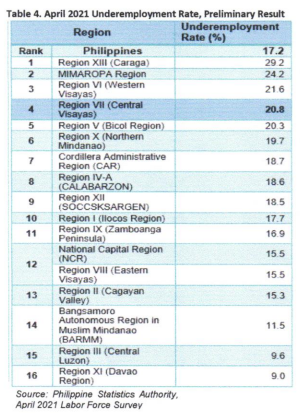The Labor Force Survey (LFS) is one of the nationwide household surveys undertaken quarterly which provides up-to-date information on the Philippine labor force and its characteristics. This survey gathers data on the demographic and socio- economic characteristics of the population and aims to provide a quantitative framework for the preparation of plans and formulation of policies affecting the labor market.
From the preliminary result of the April 2021 Labor Force Survey (LFS), Central Visayas has 5,506,000 total population of 15 years old and over wherein 67.2 percent were engaged in the Labor Force also known as the Labor Force Participation Rate (Table 1).

Labor Force Participation Rate is the percentage of the total number of persons in the labor force to the population of 15 years old and over.
The labor force population consists of the employed and the unemployed persons 15 years old and over.
The national employment rate in April 2021 was estimated at 91.3 percent. Among regions Central Visayas had an employment rate of 91.8 percent which is higher compared with the national estimate (Table 2).

In April 2021, workers were grouped into three broad sectors, namely, agriculture, industry and services sector. Workers in the services sector comprised the largest proportion of the population who are employed. It was followed by the agriculture sector and those in the industry sector are the smallest group.
Employed persons are classified as either full-time workers or part-time workers. Full-time workers refer to those who worked for 40 hours or more during the reference week, while those who worked for less than 40 hours were considered part-time workers. The reference week or reference period refers to the past seven days (moving) from the date of interview. This covers all persons aged 15 years old and over as of their last birthday.
Employed persons fall into any of these categories: (1) wage and salary workers, (2) self-employed workers without any paid employee, (3) employers in own family-operated farm or business, and (4) unpaid family workers. Wage and salary workers are those who work for private households, private establishments, government or government-controlled corporations, and those who work with pay in own family-operated farm or business.
Meanwhile unemployed persons include all those who, during the reference period, are 15 years old and over as of their last birthday who have no job/business, currently available for work and actively looking for work.
Also considered as unemployed are persons without a job or business who are reported not looking for work because of their belief that no work was available or because of temporary illness/disability, bad weather, pending job application or waiting for job interview.
The national unemployment rate in April 2021 was estimated at 8.7 percent. Central Visayas had a lower unemployment rate than the national estimate at 8.2 percent (Table 3).

By definition, employed persons who express desire to have additional hours of work in their present job, or to have additional job, or to have a new job with longer working hours are considered underemployed.
In April 2021, the underemployment rate was estimated at 20.8 percent for Central Visayas. There are three (3) other regions with higher underemployment rates compared to Central Visayas (Table 4).

Underemployed persons who work for less than 40 hours in a week are called visibly underemployed persons.
The April 2021 Employment, Unemployment, and Underemployment Rates were taken from the preliminary result of the April 2021 Labor Force Survey (LFS) conducted by the Philippine Statistics Authority (Table 5).

TECHNICAL NOTES
APRIL 2021 LABOR FORCE SURVEY
I. Introduction
a. Background
The stability and growth of a country’s economy hinges on its ability to produce goods and services for both domestic and international use. Labor represents an important factor of production, hence, the improvement of the quality of the labor force, and efforts to make it more productive and responsive to growth are necessary for the development of the economy. A clear knowledge and understanding of the size, composition and other characteristics of the segment of the population is a big step in this direction. A continuing supply of the data on labor force is indispensable to national and local development planning.
The Labor Force Survey (LFS) is a nationwide quarterly survey of households conducted by the Philippine Statistics Authority (PSA) to gather data on the demographic and socio-economic characteristics of the population.
b. Objectives
The LFS aims to provide a quantitative framework for the preparation of plans, and formulation of policies affecting the labor market.
Specifically, the survey is designed to provide statistics on levels and trends of employment, unemployment and underemployment for the country, as a whole, and for each of the administrative regions.
c. Scope and Coverage
With regions as domain, survey operations for April 2021 LFS ran from 08 to 30 April 2021, and covered 44,344 eligible sample households.
Overseas Filipino Workers are not considered part of the labor force in the Philippines. Hence, in the LFS, data on economic characteristics of household members who are overseas workers are not collected. In the LFS report, they are excluded in the estimation of the size of working population, i.e. population aged 15 years and older, and in the estimation of the labor force.
d. Developments in the LFS
The LFS, as in any survey, adopts recent developments in statistical methodology/processes and in the education system. The revisions in the LFS are as follows:
I. Concepts and Definitions
a. Reference Period
The reference period for this survey is the “past week” referring to the past seven (7) days preceding the date of visit of the enumerator or the interviewer.
b. Employment Status Concepts
1. Population 15 Years Old and Over
This refers to number of population 15 years old and over excluding overseas workers. Overseas workers are excluded in the estimation of the size of working population (population aged 15 years and over) since the data on their economic characteristics are not collected because they are not considered part of the labor force in the country.
2. In the Labor Force or Economically Active Population
This refers to persons 15 years old and over who are either employed or unemployed in accordance with the definitions described below.
3. Employed
Employed persons include all those who, during the reference period are 15 years old and over as of their last birthday, and are reported either:
a. At work, i.e., those who do any work even for one hour during the reference period for pay or profit, or work without pay on the farm or business enterprise operated by a member of the same household related by blood, marriage or adoption; or
b. With a job but not at work, i.e., those who have a job or business but are not at work because of temporary illness or injury, vacation or other reasons. Likewise, persons who expect to report for work or to start operation of a farm or business enterprise within two weeks from the date of the enumerator’s visit are considered employed.
4. Underemployed
Underemployed persons include all employed persons who express the desire to have additional hours of work in their present job, or an additional job, or to have a new job with longer working hours. Visibly underemployed persons are those who work for less than 40 hours during the reference period and want additional hours of work
5. Unemployed
Starting April 2005, the new unemployment definition was adopted per NSCB Resolution Number 15 dated October 20, 2004. As indicated in the said resolution:
Unemployed persons include all those who, during the reference period, are 15 years old and over as of their last birthday, and reported as persons:
a) Without work, i.e., had no job or business during the reference period;
b) Currently available for work, i.e., were available and willing to take up work in paid employment or self-employment during the reference period, and/or would be available and willing to take up work in paid employment or self-employment within two weeks after the interview date; and
c) Seeking work, i.e., had taken specific steps to look for a job or establish a business during the reference period, or
d) Not seeking work due to the following reasons: (1) fatigued or believed no work available, i.e., discouraged workers; (2) awaiting results of previous job application; (3) temporary illness or disability;
(4) bad weather; and/or (5) waiting for rehire or job recall.
6. Persons Not in the Labor Force
Persons 15 years old and over who are neither employed nor unemployed according to the definitions mentioned. Those not in the labor force are persons who are not looking for work because of reasons such as housekeeping, schooling and permanent disability. Examples are housewives, students, persons with disability, or retired persons.
II. Sampling Design and Estimation Methodology
The LFS, being a household-based survey, used the 2013 Master Sample (MS) design of which 4 replicates equivalent to a total of 42,768 Secondary sampling Units (SSUs) or sample housing units were included as samples. Using a two-stage cluster sampling design, EAs/barangays were selected at the initial sampling stage as the primary sampling units (PSUs), while the housing units within the selected PSUs are selected as the secondary sampling units (SSUs). Generally, all households within the sample housing unit are also considered as sample households. However, for housing unit with more than three (3) households, a maximum of three (3) sample households were randomly selected.
Sampling Frame
The 2013 MS sampling frame was constructed based on the results of the 2015 Population Census. The EA Reference File (EARF) of the 2015 Census of Population was used as the PSU frame while the 2015 list of households for each of the PSUs were used as the SSU frame
Sampling Domain
To provide subnational or provincial level statistics with precise estimates, the 2013 MS has 117 major domains as follows: 81 provinces (including the newly created province Davao Occidental); 33 highly urbanized cities (including 16 cities in the National Capital Region); and 3 other areas (Pateros, Isabela City, and Cotabato City).
Primary Sampling Units
In the 2013 Master Sample Design, each sampling domain (i.e., province/HUC) is divided into exhaustive and non-overlapping area segments known as Primary Sampling Units (PSUs) with about 100 to 400 households. Thus, a PSU can be a barangay/Enumeration Area (EA) or a portion of a large barangay, or two or more adjacent small barangays/EAs.
2x2x2 Implicit Stratification
The PSUs are then ordered according to the following: (1) North-South/West-East Geographic location; (2) Decreasing Proportion of HHs with Overseas Worker; and (3) Decreasing wealth Index.
Replicates
Four replicates are used in all 117 sampling domains. A replicate is composed of ordered list of PSUs. Most of the provinces, that is, 75 out of 81, has six PSUs per replicate while in HUCs, eight PSUs form a replicate. Small domains such as Guimaras, Siquijor, Camiguin, Apayao, and Dinagat Islands had three PSUs per replicate.
Sample Allocation Scheme
A total of four sample replicates were allotted. However, the total number of sample SSUs was allotted proportionately to the measure of size of the PSU. Thus, a PSU with only 100 HHs had less number of sample HHs than PSUs with 400 HHs but, on the average, there were 12 sample HHs allotted for each PSU in Highly Urbanized Cities (HUCs) and an average of 16 sample HHs for every PSU in the province.
A total national sample of 42,768 sample HHs was allotted for the quarterly rounds of the LFS.
Further processing in the regional office such as ID validation, and completeness check, edit and matching of LFS sample households with the original List from Master Sample (MS) Form 6 were done to ensure that the number of household listed was fully covered.
Preliminary, and final tabulations of data were done at the PSA Central Office.
Approved by:
ARIEL E. FLORENDO
Regional Director

